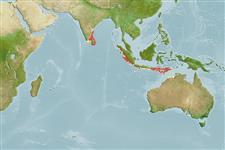>
Eupercaria/misc (Various families in series Eupercaria) >
Labridae (Wrasses) > Cheilininae
Etymology: Cirrhilabrus: Latin, cirrus = curl fringe + Greek, labros = furious (Ref. 45335); adornatus: Named in reference to the bright red markings on the body and dorsal fin (Ref. 31269).
More on authors: Randall & Kunzmann.
Environment: milieu / climate zone / Tiefenbereich / distribution range
Ökologie
seewasser riff-verbunden; tiefenbereich 10 - 30 m (Ref. 31269). Tropical
Eastern Indian Ocean: known only from Indonesia (Sumatra and the Mentawai Islands).
Size / Gewicht / Alter
Geschlechtsreife: Lm ? range ? - ? cm
Max length : 6.3 cm SL Männchen/unbestimmt; (Ref. 31269)
Rückenflossenstacheln (insgesamt) : 11; Rückenflossenweichstrahlen (insgesamt) : 9; Afterflossenstacheln: 3; Afterflossenweichstrahlen: 9; Wirbelzahl: 25. Scales above lateral line to origin of dorsal fin 1.5. Caudal fin of females slightly rounded or truncate, double emarginate or emarginate in males. Males whitish to pale pink with two large triangular bright red blotches dorsoanteriorly on body and a broad red border on dorsal fin except posteriorly (some with a longitudinal row of small black spots near middle of fin); females red, shading to white ventrally on head and abdomen, with a black spot three-fourths orbit diameter posteriorly on side of caudal peduncle above lateral line (Ref. 31269).
Body shape (shape guide): fusiform / normal; Cross section: compressed.
Found over rubble on outer reef slopes up to at least 30 m depth (Ref. 31269). Closely related to C. flavidorsalis and females look almost identical (Ref. 48636).
Life cycle and mating behavior
Geschlechtsreife | Fortpflanzung | Ablaichen | Eier | Fecundity | Larven
Distinct pairing during breeding (Ref. 205).
Randall, J.E. and A. Kunzmann, 1998. Cirrhilabrus adornatus, a new species of labrid fish from Sumatra. Rev. Fr. Aquariol. 25(1-2):41-44. (Ref. 31269)
IUCN Rote Liste Status (Ref. 130435: Version 2025-1)
Bedrohung für Menschen
Harmless
Nutzung durch Menschen
Tools
Zusatzinformationen
Download XML
Internet Quellen
Estimates based on models
Preferred temperature (Ref.
123201): 20.8 - 29.2, mean 28.4 °C (based on 10 cells).
Phylogenetic diversity index (Ref.
82804): PD
50 = 0.5000 [Uniqueness, from 0.5 = low to 2.0 = high].
Bayesian length-weight: a=0.01585 (0.00700 - 0.03587), b=2.95 (2.76 - 3.14), in cm total length, based on LWR estimates for this (Sub)family-body shape (Ref.
93245).
Trophic level (Ref.
69278): 3.3 ±0.4 se; based on size and trophs of closest relatives
Widerstandsfähigkeit (Ref.
120179): hoch, Verdopplung der Population dauert weniger als 15 Monate. (Preliminary K or Fecundity.).
Fishing Vulnerability (Ref.
59153): Low vulnerability (10 of 100).
🛈
